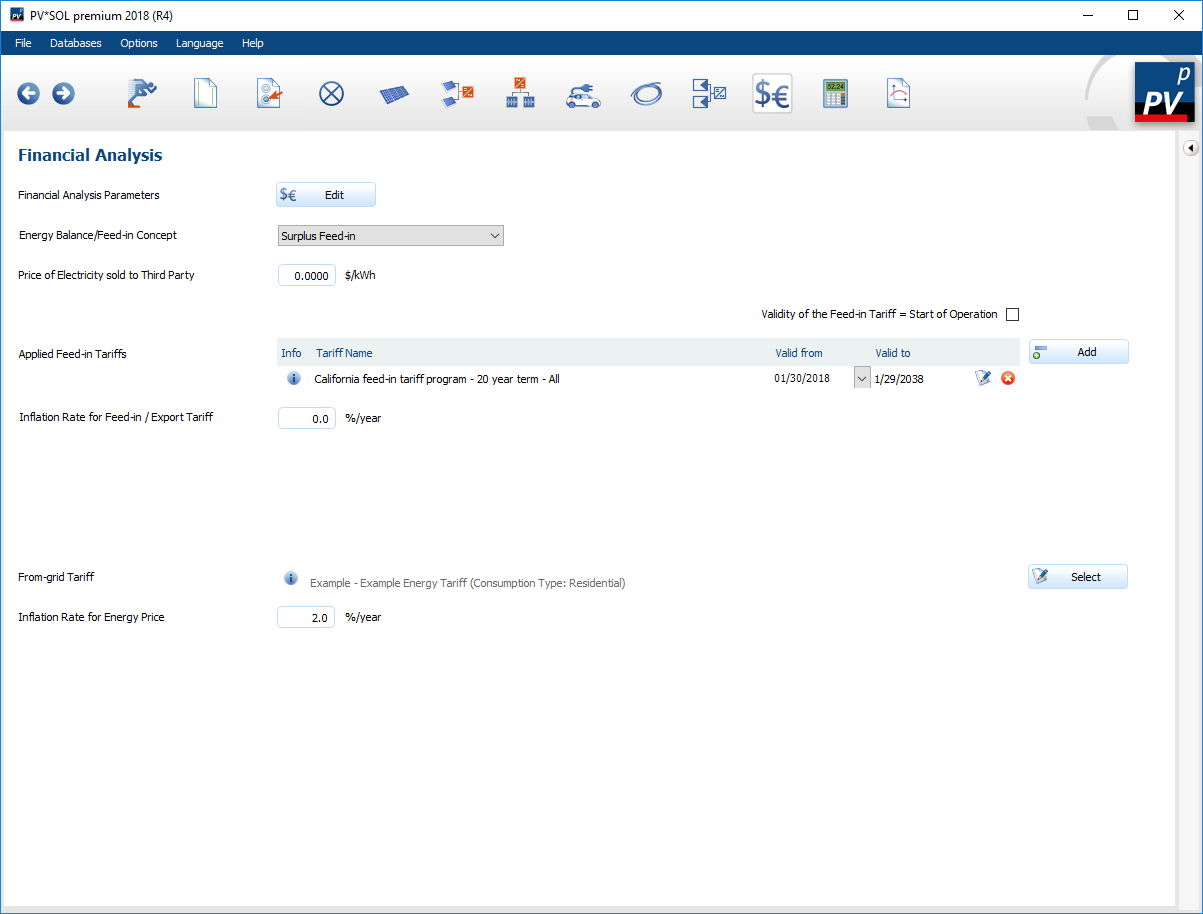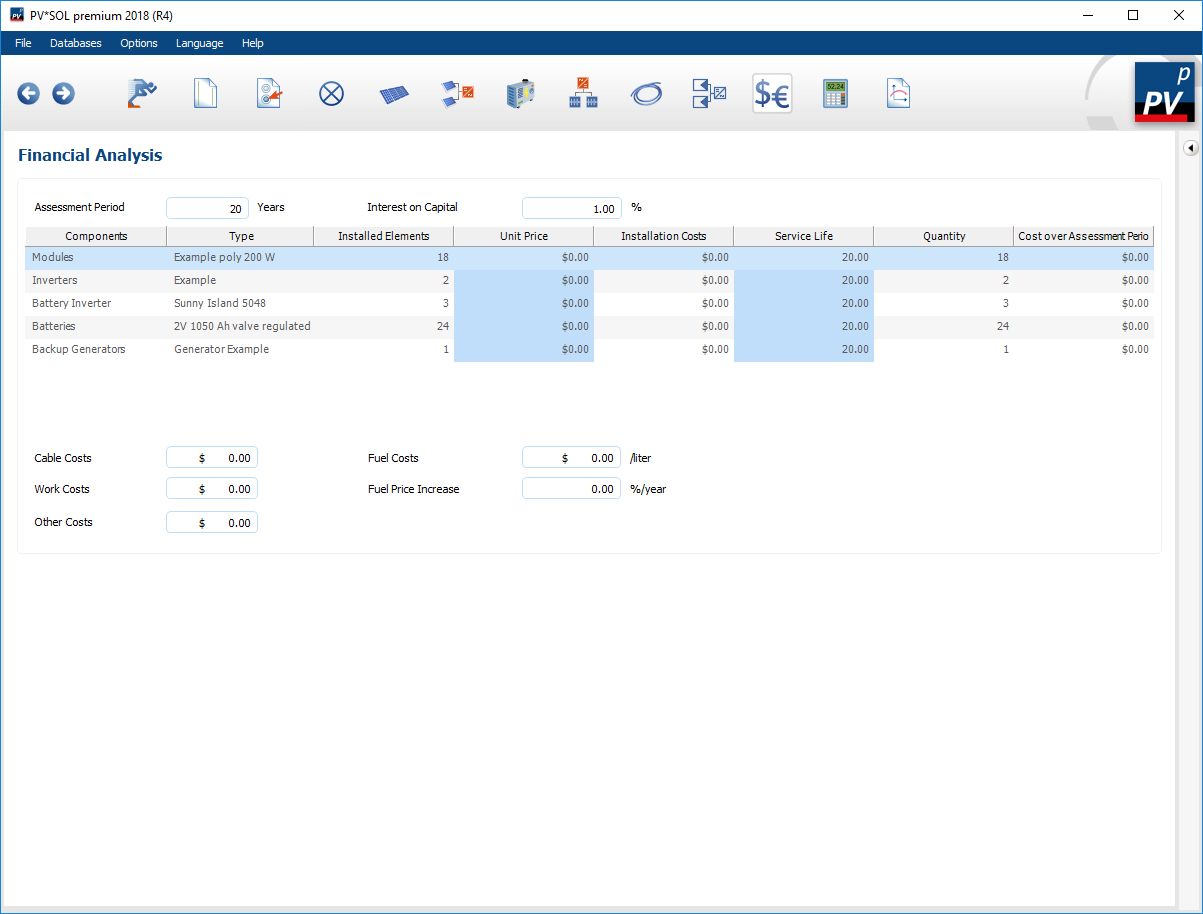Financial Analysis
On the page
![]() Financial Analysis all information required for the economic efficiency calculation such as costs, subsidies and electricity tariffs are defined.
Financial Analysis all information required for the economic efficiency calculation such as costs, subsidies and electricity tariffs are defined.
Economic efficiency calculation (grid-connected)
To enter the parameters for calculating the profitability of grid-connected systems:
-
Use button
 to enter the economic efficiency parameters.
to enter the economic efficiency parameters. -
Select a balancing or feed-in concept of the PV system
You can choose between the following feed-in concepts:
-
Full feed-in
With a full feed-in, the entire electrical energy generated by the PV system is fed into the public power grid. There is no own consumption. The profitability of the plant depends directly on the amount of the feed-in tariff or the proceeds from direct marketing. The full supply can only be selected for grid-connected PV systems without electrical loads.- Specify a price for directly marketed electricity
- Select the Applied feed-in tariffs
- Using the
 button, feed-in tariffs can be added from the database
button, feed-in tariffs can be added from the database - Existing tariffs can be edited using the
 button or deleted using
button or deleted using

- For further information see feed-in tariffs
- Using the
- Specify a price change factor feed-in tariff
- Only available if an appropriate tariff has been selected
- Specify a price change factor for internal consumption remuneration
- Only available if an appropriate tariff has been selected
- (optional) Make specifications for bankability or financing protection
- If not chosen otherwise, an exceedance probability of 50% is assumed.
- For further information see Bankability (P50/P90)
-
Surplus supply
In the event of an excess supply, the electrical energy generated by the PV system is used for the electrical consumers, battery systems or electric vehicles as far as possible. Only the energy that cannot be used is fed into the power grid. The current consumption and the feed into the grid are measured via two separate meters. The profitability of the PV system results from savings in electricity purchases and feed-in tariffs.- Specify a price for directly marketed electricity
- Select the Applied feed-in tariffs
- Using the
 button, feed-in tariffs can be added from the database
button, feed-in tariffs can be added from the database - Existing tariffs can be edited using the
 button or deleted using
button or deleted using

- For further information see Feed-in tariffs
- Using the
- Specify a price change factor feed-in tariff
- Only available if an appropriate tariff has been selected
- Specify a price change factor for internal consumption remuneration
- Only available if an appropriate tariff has been selected
- Select the From-grid tariffs
- From-grid tariffs can be added from the database using the
 button
button - Existing tariffs can be edited using the
 button or deleted using
button or deleted using

- The selected tariff is valid by default from the date the PV system is commissioned
- If you add a from-grid tariff
 , the tariff is automatically assigned to an existing consumer. The assignment of the consumer to the from-grid tariff can be changed using the selection list for consumers. As many purchase tariffs must be added as there are consumers in the project. This allows, for example, tenant electricity models or own heat pump tariffs to be mapped.
, the tariff is automatically assigned to an existing consumer. The assignment of the consumer to the from-grid tariff can be changed using the selection list for consumers. As many purchase tariffs must be added as there are consumers in the project. This allows, for example, tenant electricity models or own heat pump tariffs to be mapped. - For further information see From-grid tariffs
- From-grid tariffs can be added from the database using the
- Choose a price change factor energy price
- Germany only: Choose the Number of hours per year with negative electricity price (so called “Solarspitzen-Gesetz”)
-
Net Metering
As with the surplus feed-in, the electrical energy generated is primarily used for self-sufficiency. The unused electricity is fed into the power grid via a double-tariff meter and offset against the electricity purchased. The tariff counter rotates backwards. If more solar power is generated than consumed in the billing period, the surplus can be carried forward as a balance to the next billing period.- Enter a price for directly marketed electricity
- Use the button
 to select a Net-Metering tariff from the database
to select a Net-Metering tariff from the database
- The selected tariff is valid as standard from the date of commissioning of the PV system.
- For further information see Net-Metering Tariffs
- Choose a price change factor energy price
-
If the desired rate does not exist in the database, you can also create your own rates and use them. See: Net-metering tariffs, Delivery tariffs, Feed-in tariffs.
The feed-in tariff can consist of different feed-in tariffs with different validity periods.
Solar Peak Law
Only relevant in Germany
This feature calculates the non-remunerated hours due to negative exchange electricity prices in accordance with the amendment to the Energy Industry Act (‘Solar Peaks Act’). In addition, the compensation period is calculated in accordance with §51 of the EEG. Both are included in the calculation of profitability in PV*SOL®.
The times in 2024 when the exchange electricity price was actually negative serve as the basis for calculating the hours for which compensation was not paid. The total number of hours affected in 2024 was 459.
If a value less than 459 is entered, the corresponding number of hours is randomly selected from the actual hours. This ensures that the times correspond to the real distribution (time of day and time of year).
If a value greater than 459 is entered, the next ‘free’ time next to a randomly selected 2024 hour is searched for each additional hour.
Economic efficiency calculation of off-grid PV system
To enter the parameters for the profitability calculation:
- Specify the observation period and the interest on principal as boundary conditions
- Enter the unit prices and the lifetime of the system components in the blue fields of the table
- The lifetime is set to the duration of the observation period by default, but can be adjusted as required.
- The number is calculated from the number of installed elements, the specified lifetime and the analysis period, i.e. it describes the total number of elements required in the analysis period.
- Specify the costs of the cables, the labor costs and the other costs as boundary conditions
- To define the fuel dependent costs, enter the fuel costs and the fuel price increase.
See also

